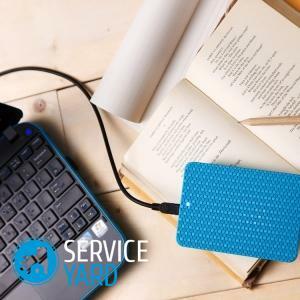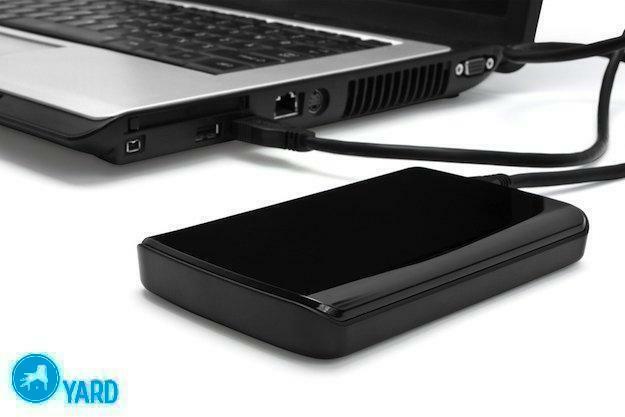
- The computer does not see the external hard drive. Reasons for
- If you do not see the old external hard drive
- Helpful hints:
External hard drives are becoming more popular with PC users every day. The thing is that very often on the built-in storage of information there is not enough space, and to not change the medium, you can use HDD( external hard drive).A modern model of such a device is a small box containing 1-2 TB of information. But what if the computer does not see an external hard drive, and, right after the purchase of a new device. Today we will try to understand the situation and tell you what to do if the computer does not see a removable hard disk, depending on the cause of the problem.
to the contents ↑The computer does not see the external hard drive. Causes of
Before solving the problem, it is necessary to understand the cause of the malfunction. Let's consider the main ones.
Insufficient supply of
If the hard drive is large enough, its lack in the "File manager" can be caused by insufficient power. This situation occurs if you use a USB-splitter, on which other devices are already connected. All USB-interfaces, depending on the type, produce different power.
Important! Try to insert the connecting cable into different USB jacks. Perhaps one of the connectors can provide enough power to operate the device. Or connect the media directly to the port.
Connection cable breakage
The cable replacement will help to correct the situation.
The HDD model has a different connection, not the USB
Today there are a lot of devices on the market that have different parameters and connection. Some devices require a separate cable to connect the power. All these nuances must be checked during the purchase on the technical description.
Important! Perhaps you connected the device, as usual - via USB, and it was necessary to use an additional power cable.
Problem in the
settings If the computer does not see an external hard drive, the reasons can also be:
- The problem with the drivers. If the operating system can not correctly determine the driver for an external drive, you should download them from the official site. If you have a new medium, the drivers must be written on it.
Important! Extract them to another computer that has been able to recognize the device.
- USB support is not included in the BIOS.If another computer detects an external drive, then check if USB support is enabled on your PC.
- The device is malfunctioning. If the manipulations with the USB connection do not work, then check that the device works by connecting it to another computer, the drive may be faulty. In case of mechanical failure, contact the service center.
Important! In order to prevent and solve these problems:
- Choose a cord for connecting the device as short as possible in length and as thick as possible. All this significantly affects the transmission of power.
- The problem with the lack of power can be solved in this way: connect the cable with two connectors at one end in different slots on the chassis of the system unit. Thus, the device will receive electricity from two sources.
What if the problem is in the
settings? In order for the computer to identify the device, there must be a name in the management interface of the removable storage medium. But sometimes it happens that the disk is not detected because of an incorrect configuration in the BIOS.You can correct the situation by going into the settings and changing the configuration to another one proposed from the list. After these manipulations, restart the computer.
Detailed instructions:
- Click the Start menu.
- Click "Computer Control Panel".
- Make sure that you browse the items by category( in the upper right corner of the inscription "View").
- Click on "System and Security".
- Find the item "Administration".
- In the opened window, find the item named "Computer Management".
- In the left window that opens, select "Disk Management".You should be able to see all the disks connected to the system, including external ones. Your task is to change the drive letter to the one that is not in the operating system.
- Find in the window your external source of information, and then right click on it and select "Change drive letter or path to disk".
- In the opened window, select "Change".
- Choose any letter you like.
- Click "OK."
Important! If you connect the first time a new drive to the computer, most likely it is not formatted, so it will not be displayed in the My Computer window. In this case, you can not change the letter. Right-click on the external drive and select "Create a simple volume", but remember that with this process all data on the storage media will be deleted.
Problems with
applications Problems with the fact that the computer does not see an external hard drive often arise after working with programs such as Acronis and Alcohol, other similar applications for creating virtual storage media. In the process of working with such programs, the PC switches to communication with virtual disks, and real ones - it ceases to see.
In this situation, you must return the system to its previous state or completely remove the program along with all the settings.
Important! Check if there are any previously created virtual disks in the system. If available, remove them and reboot the computer, resetting the CMOS settings to their default settings.

Solving the problem with
drivers If the external drive is new and it is not in the My Computer window, then 99% of this phenomenon is due to drivers. Proceed as follows:
- From the control panel, go to the "Device Manager" tab. Make sure that you are viewing the menu with small icons( upper right corner).
- Expand the "Disk Devices" tab.
- Note that the exclamation point in the yellow triangle is not displayed opposite the drive. If there is a triangle, update the driver.
Important! If you did not find your drive, then try to find it in "Other Devices".
- Remove the old driver by right-clicking on the device and selecting the "Delete" task.
- Disconnect the device and turn it back on in a minute to the USB port. The driver must be automatically defined and installed.
Important! Usually, the operating system Windows 7 and 8 when connecting any new device automatically installs a driver for it. If this does not happen, click the "Actions" command in the device manager - "Update hardware configuration" or download the driver from the official site of the manufacturer of the HDD device.
to the contents ↑If you do not see the old external hard drive
If the external media has previously worked on your computer and then stopped, then proceed as follows:
- Check USB, through which you connect the drive by connecting any other device( phone, player, printer, etc.).If necessary, reinstall the USB controller driver.
- Check cords for damage. The wire should not be damaged, and the USB plugs are tightly connected to the computer and HDD.If necessary, replace the cord with a new one.
- Go to the control menu and change the drive letter as described above. Do this necessarily in the event that you created new partitions on your hard drive.
- Check external HDD for viruses. Some viruses block disks and disable the ability to see them.
- Go to "Device Manager" and find out if the device is detected correctly. There should not be any exclamatory yellow or red signs that signal errors.
- Test the hard drive on another computer or laptop. In this case, perhaps, the reinstallation of the operating system will help.
Useful advices:
- The problem can sometimes be determined by hearing. For example, if the power indicators are lit when turned on, but no movement is heard, the disc is defective. If unusual sounds are heard, intermittent strokes and knocking, then faults with the internal mechanism of the device.
- If the hard drive is still not visible in disk management, there may be a conflict between the disk controller and the computer, or the reason lies in the hard drive itself.
Important! The hard drive can be tested as follows: disconnect the HDD and connect directly to the motherboard. The motherboard determines the disks are much more stable than the controllers. Turn on the computer: if the disk is detected, then the controller is to blame, if not, the problem is in the disk.
Buy removable drives and other devices only of well-known companies. Their refusals are much less frequent. If all the above tips and recommendations did not help fix the situation, unplug the device from the computer and contact the service center.
